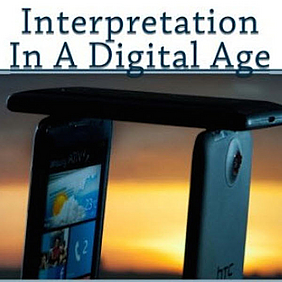Native or progressive apps, frame rates or bit rates, QR codes or NFC tags – it is too easy to confuse readers with technology terms. In Interpretation in a digital age, Paul Palmer and Neil Rathbone do exactly the opposite.
This new, easy to read guide, aimed at heritage interpreters and site managers, provides an accessible walk through the background and current technologies surrounding the use of smartphones and tablets: from apps, and augmented reality, to beacons, webcams and video. It also describes practical, strategic approaches to managing an area of technology that is subject to rapid change and obsolescence.
Engineer and lead author Paul Palmer explains, ‘I have seen a lot of misleading information, commercial hype, and technical jargon that can lead people into making mistakes. Digital installations should enjoy a ten-year horizon, and need not become defunct in months, or too expensive to maintain.’
‘Do you really need an app?’ What a nice question for a subtitle in a book about digital technologies, notes Thorsten Ludwig. It is not the only question of that kind. The authors clearly see that access through digital media is not almost the same as first-hand experience (or might be soon) and discuss how the first can best support the latter. As a consequence, Interpretation in a digital age carefully notes not just the pros but also the cons of numerous technological approaches on a case-by-case basis.
Even more appealing to Thorsten is the way the individual features are described. Although each of the twelve chapters opens with a full-page illustration, there are almost no pictures within the generously set text blocks – and nevertheless the 178 pages almost read themselves. All who think text on digital technologies needs to be complicated will realise that this is simply not the case. Thorsten admits he is truly no technology buff but read half of the book during an afternoon tea break, especially enjoying the short bullet point-like summaries at the end of each chapter.
Terry Lilley agrees: The ‘key knowledge’ at the end of each chapter is very helpful. The clear, well laid out text is succinct yet always with adequate detail for the non-technical audience. Terry is sure the book will fulfill the need for the authors’ target market exactly as stated on the back cover. Although Terry is familiar with a range of IT aboard ‘Wellington’ (the ship on which he works), the book gives a handhold in using computers in interpretation for the first time. From experience aboard ‘Wellington’, the expectations of Terry and his colleagues are that tablets and phones will compensate for a shortage of ‘wall space’ for interpretion.
Matthew Tyler-Jones thinks the book lives up to its promise of giving "objective and practical guidance". A useful chapter on accessibility and inclusiveness concludes with a section on mindfulness, wherein the authors argue we "need to develop more skill in the psychology of storytelling using digital media rather than blame the media". A sentiment with which Matthew agrees, given the subject of his PhD study.
In addition to the chapters walking the reader through the types of handheld technology, there are chapters on using technology outdoors, understanding wifi, compliance and intellectual property, and project management. Matthew highlighted an optimistic chapter near the end of the book, which explores some of the possibilities that ‘the digital toolbox’ might enable, and we all liked the fact that the book ends with a jargon busting glossary to aid the intended audience of museum and cultural heritage professionals who are not digital experts but are thinking of commissioning something and don’t want to be fast-talked by potential suppliers.
Matthew notes: It’s not an academic work, it doesn’t have references to other texts. Rather it is based on the practical experience to the two authors. So, it’s very good, if not technically detailed, on the how – and also offers practical advice on project management that will last longer than some of the technologies that are now current – but it lacks the why. It’s not their intention (Matthew thinks) to sell the concept of digital technology to heritage sites, rather it’s a response to heritage sites looking to see what is possible. Indeed, in the introduction the authors refer to the "Gartner hype cycle", the tendency to over-estimate the potential of technology, and potential to be disappointed by its limitations. Given that more and more evidence Matthew sees in his PhD study suggests only a maximum of 5% of heritage visitors use apps or other mobile technologies, he still questions whether it’s possible to build a business case for the creation of digital content, let alone the purchase of hardware etc.
However, we all agree that if you need a straight-talking reference to better understand the technologies available to augment your interpretation, and are looking for practical tips clearly based on sound knowledge and experience of the sector, then this would be a solid investment for your bookshelf. Should it be available as an e-book?!
Our views on the price of the book:
Thorsten Ludwig: Of course, one could ask whether being entertained during two tea breaks is worth the €23.50 but for myself I must say: yes, it is. For those who are not using digital technologies in interpretation on a daily basis, this is the lightest introduction I’ve seen.
Terry Lilley: The Project Management chapter is a fund of straight forward common sense, clearly based on the scars of experience. This chapter alone makes the cost of the book (£18 in the UK) good value.
Marie Banks: Being able to find all the ‘Key knowledge’ (lessons learned) for each type of technology in one handy book is invaluable and the honesty with which it is presented is refreshing and worth the investment.
Book citation:
Paul Palmer and Neil Rathbone (2017) Interpretation in a digital age: understanding the range of digital technologies available for heritage interpretation. North Charleston: CreateSpace. ISBN: 1533253072.
The book is in English and available from Amazon US at:
https://www.amazon.com/dp/1533253072
and from local Amazon sites e.g.:
UK https://www.amazon.co.uk/dp/1533253072
FR https://www.amazon.fr/dp/1533253072
DE https://www.amazon.de/dp/1533253072
Marie Banks is the News Coordinator for Interpret Europe and manages her own business, Zebraproof.uk. She can be contacted at: marie.banks@interpret-europe.net.
Terry Lilley is a Research Volunteer aboard the HQS Wellington ship in London. He can be contacted at: tdlilley@btinternet.com.
Thorsten Ludwig is Managing Director of Interpret Europe and manages his own business, Bildungswerk interpretation. He can be contacted at thorsten.ludwig@interpret-europe.net.
Matthew Tyler-Jones is studying for a PhD in Interpretive Technology at Southampton University and is also a visitor experience consultant for the National Trust. You can read his full review of Interpretation in a digital age on his blog and contact him via: www.memetechnology.org.
Paul Palmer and Neil Rathbone also created the Info-Point, a mobile, stand alone internet browser for areas with no internet connection. Further information and contact details can be found at: www.webnebulus.co.uk
To cite this article:
Banks, Marie, Lilley, Terry, Ludwig, Thorsten & Tyler-Jones, Mattew (2017) ‘Interpretation in a digital age: A review of this new guide’. In Interpret Europe Newsletter 3-2017, 19-20.




